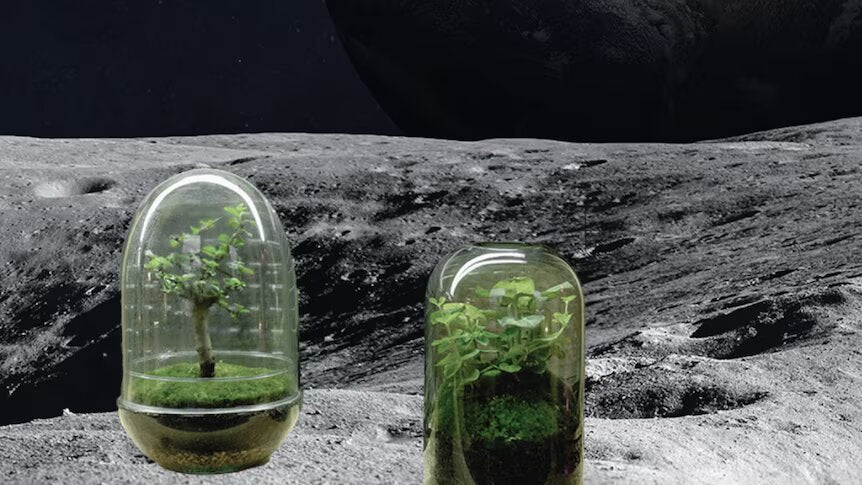
Bloomin' Marvellous: Aussie Scientists to Put Plants on the Moon
Share
In a groundbreaking endeavour, the Australian Government has boldly backed a plan to cultivate seedlings on the Moon by 2026. The audacious project, known as the Australian Lunar Experiment Promoting Horticulture (ALEPH), aims to shed light on the mysteries of horticulture in extreme environments. Led by the innovative start-up Lunaria One, in collaboration with esteemed Australian universities RMIT, QUT, and ANU, along with industry bodies, ALEPH has secured a significant $3.6 million grant as part of the Australian Space Agency's Moon to Mars Initiative.
While the primary focus is to investigate the growth of seedlings on the lunar surface for future space exploration, the knowledge gained could also provide invaluable insights into adapting plant growth in a changing climate here on Earth.
Dr. Graham Dorrington, a co-founder of Lunaria One and engineering lead for the project at RMIT, shared the ambitious plans. Specially designed chambers, equipped with sensors, water, and cameras, will transport the seeds and plants aboard a lunar lander scheduled for a momentous mission in 2026. However, the team faces immense challenges in designing a chamber that can sustain suitable conditions for germination on the lunar surface, where temperatures fluctuate between scorching highs of 80°C and bone-chilling lows of –180 °C.

Not only must the chamber be lightweight, weighing no more than 1.5 kg, but it also needs to operate on minimal power while transmitting crucial data back to Earth via the lander, using data rates of less than 40 kb/s. Despite these formidable obstacles, Dr. Dorrington expressed confidence in RMIT's capable staff and cutting-edge facilities to overcome them.
RMIT's School of Science, led by Associate Professor Tien Huynh, will contribute expertise in plant biology to the project. The team aims to understand how plants grow differently under altered gravity conditions and how they can adapt to the harsh lunar environment, characterised by a thin atmosphere, rapid temperature changes, and poor soil properties.
Among the plants under consideration for the mission is Rapeseed (Brassica napus), renowned for its yellow flowers and various uses in food production and industry. Initial findings suggest Rapeseed possesses the necessary qualities, such as extreme temperature tolerance and rapid germination, to withstand a mission to the Moon or Mars.
Following the lunar landing, the plants' growth and well-being will be closely monitored, with data and images beamed back to Earth. RMIT's expertise in computer science will also contribute to data compression, ensuring the efficient transmission of information. Professor Ian Burnett, RMIT's Deputy Vice-Chancellor of STEM College and Vice-President, emphasised the project's interdisciplinary nature and its potential to provide valuable insights into supporting horticulture in extreme climates on Earth.
In an inclusive approach, citizen scientists and school children worldwide will have the opportunity to analyse the data and conduct their own experiments, determining which plant varieties have the greatest chance of thriving on the Moon.

Lauren Fell, Director of Lunaria One, emphasised the project's core value: making space exploration accessible to all. Rejecting a future dominated by autonomous machines, ALEPH aims to involve humans in shaping the path to space colonisation. By demystifying the science and engineering behind lunar plant growth, the project seeks to engage and empower everyone.
This collaboration with Lunaria One bolsters RMIT's burgeoning space industry ecosystem, united under the university's Space Industry Hub. A team of twelve RMIT engineers, scientists, educators, and industrial design students are dedicated to this remarkable undertaking. Ben Gurion University in Israel will provide expert knowledge to the plant biology team, coordinating the inputs of international experts, while ANU will organise supporting workshops.
For more information about the Australian Lunar Experiment Promoting Horticulture (ALEPH) project, visit the Lunaria One website. The future of lunar gardening awaits!
ARSE Jnr
The section where we explain the above to 5-year-olds (and Flat Earthers).
Australian scientists have an incredible plan - they want to grow plants on the Moon! This project is called ALEPH, and it will help us learn how plants can grow in extreme places. The scientists will send special chambers with seeds and plants to the Moon, and they will study how they grow. Kids from around the world can also join in and do their own experiments. Imagine having a garden on the Moon one day!
You’ve come this far…
Why not venture a little further into A.S.S. - our exclusive Australian Space Society.
And keep thrusting Australia into the deep unknown…
#Space_Aus




